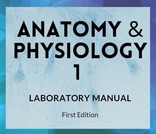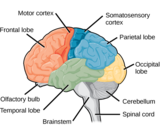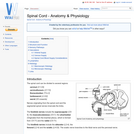
Laboratory manual for undergraduate Anatomy & Physiology 1
- Subject:
- Anatomy/Physiology
- Biology
- Health, Medicine and Nursing
- Material Type:
- Activity/Lab
- Reading
- Teaching/Learning Strategy
- Textbook
- Author:
- Julie Robinson
- Date Added:
- 06/05/2021

Laboratory manual for undergraduate Anatomy & Physiology 1

This course considers the process of neurotransmission, especially chemicals used in the brain and elsewhere to carry signals from nerve terminals to the structures they innervate. We focus on monoamine transmitters (acetylcholine; serotonin; dopamine and norepinephrine); we also examine amino acid and peptide transmitters and neuromodulators like adenosine. Macromolecules that mediate neurotransmitter synthesis, release, inactivation and receptor-mediated actions are discussed, as well as factors that regulate their activity and the second-messenger systems and ion fluxes that they control. The involvement of particular neurotransmitters in human diseases is considered.

Biology is designed for multi-semester biology courses for science majors. It is grounded on an evolutionary basis and includes exciting features that highlight careers in the biological sciences and everyday applications of the concepts at hand. To meet the needs of today’s instructors and students, some content has been strategically condensed while maintaining the overall scope and coverage of traditional texts for this course. Instructors can customize the book, adapting it to the approach that works best in their classroom. Biology also includes an innovative art program that incorporates critical thinking and clicker questions to help students understand—and apply—key concepts.



By the end of this section, you will be able to:Identify the spinal cord, cerebral lobes, and other brain areas on a diagram of the brainDescribe the basic functions of the spinal cord, cerebral lobes, and other brain areas

Students build small-sized prototypes of mountain rescue litters rescue baskets for use in hard-to-get-to places, such as mountainous terrain to evacuate an injured person (modeled by a potato) from the backcountry. Groups design their litters within constraints: they must be stable, lightweight, low-cost, portable and quick to assemble. Students demonstrate their designs in a timed test during which they assemble the litter and transport the rescued person (potato) over a set distance.

This resource is a video abstract of a research paper created by Research Square on behalf of its authors. It provides a synopsis that's easy to understand, and can be used to introduce the topics it covers to students, researchers, and the general public. The video's transcript is also provided in full, with a portion provided below for preview:
"Harmful masses that accompany regular spinal or intrathecal infusions of opiates for pain management might one day be a concern of the past. Researchers have uncovered the cellular mechanisms behind these lesions, which occur with some opioids but not others. Their findings could help improve spinal pain therapy for patients without compromising their health or quality of life. Intrathecal opioids such as morphine are highly effective for managing pain. Direct access to opioid receptors in the spinal cord has made round-the-clock pain management possible, most notably through the use of so-called “pain pumps”. One concern, however, has been the possible formation of collagen-rich masses around the area of drug delivery. These masses, or granulomas, occur in about 8% of patients receiving spinal morphine infusions and have been linked, ironically, to increased pain and reduced neurological function..."
The rest of the transcript, along with a link to the research itself, is available on the resource itself.

This resource is a video abstract of a research paper created by Research Square on behalf of its authors. It provides a synopsis that's easy to understand, and can be used to introduce the topics it covers to students, researchers, and the general public. The video's transcript is also provided in full, with a portion provided below for preview:
"Scientists at the University of Wisconsin have demonstrated that, in male rats, nitrous oxide impairs axon regeneration after multiple types of injuries. Importantly, their results could point toward a possible mechanism. Reporting in the journal Anesthesiology, the authors discuss the effects of nitrous oxide in four model systems: an in vitro evaluation of axon regeneration following a sciatic nerve injury, in vivo tests of regeneration following a sharp spinal cord or an optic nerve injury, and a test of functional recovery after a blunt spinal cord injury. In most experiments, a group of male rats received either a single 70-percent dose of nitrous oxide for two hours, a series of 80-percent doses, or no gas, and were injured or not, in the case of the controls. In some experiments, the rats also received folic acid supplementation, which helps spur axonal recovery. All experiments showed that nitrous oxide reduced the amount of axonal recovery following an injury..."
The rest of the transcript, along with a link to the research itself, is available on the resource itself.

The course will start with an overview of the central and peripheral nervous systems (CNS and PNS), the development of their structure and major divisions. The major functional components of the CNS will then be reviewed individually. Topography, functional distribution of nerve cell bodies, ascending and descending tracts in the spinal cord. Brainstem organization and functional components, including cranial nerve nuclei, ascending / descending pathways, amine-containing cells, structure and information flow in the cerebellar and vestibular systems. Distribution of the cranial nerves, resolution of their skeletal and branchial arch components. Functional divisions of the Diencephalon and Telencephalon. The course will then continue with how these various CNS pieces and parts work together. Motor systems, motor neurons and motor units, medial and lateral pathways, cortical versus cerebellar systems and their functional integration. The sensory systems, visual, auditory and somatosensory. Olfaction will be covered in the context of the limbic system, which will also include autonomic control and the Papez circuit. To conclude, functional organization and information flow in the neocortex will be discussed.

The course will span modern neuroscience from molecular neurobiology to perception and cognition, including the following major topics: anatomy and development of the brain; cell biology of neurons and glia; ion channels and electrical signaling; synaptic transmission, integration, and chemical systems of the brain; sensory systems, from transduction to perception; motor systems; and higher brain functions dealing with memory, language, and affective disorders.

This resource is a video abstract of a research paper created by Research Square on behalf of its authors. It provides a synopsis that's easy to understand, and can be used to introduce the topics it covers to students, researchers, and the general public. The video's transcript is also provided in full, with a portion provided below for preview:
"New research shows that hyperalgesia, a neuropathic condition causing heightened sensitivity to pain, can be effectively reversed in a human experimental model. For the hundreds of thousands who suffer from this hard-to-treat condition, the study’s findings could offer much-needed pain relief. Treating neuropathic pain is notoriously difficult. Clinicians must wade through numerous patient-reported symptoms just to source the pain. And even when the presence of neuropathy is established, finding a treatment that works can be painstaking. In recent years, researchers have focused on neural receptors of N-methyl-D-aspartate, or NMDA; these receptors are linked to the central sensitization that gives rise to hyperalgesia. Specifically, they’ve explored the effects of NMDA receptor antagonists, such as ketamine, memantine, and dextromethorphan. Dextromethorphan has proven especially effective in combating hyperalgesia..."
The rest of the transcript, along with a link to the research itself, is available on the resource itself.

This lesson describes the function and components of the human nervous system. It helps students understand the purpose of our brain, spinal cord, nerves and the five senses. How the nervous system is affected during spaceflight is also discussed in this lesson.

Continuing our look at the nervous system, we take a survey of the components of the central nervous system. Covered in this video: Cerebrum, Cerebellum, Brainstem and the spinal cord.
Lesson 10 in our Nervous System series. This is part of our Anatomy and Physiology lecture series.
If this video helps you please be sure to LST -like subscribe and tell your friends. Your support help us make more videos. For the complete series please visit http://mrfordsclass.net/
Videos in the skeletal system series:
- Introduction (10:01): http://youtu.be/HX1bsdHLC58
- Neurons (10:02): http://youtu.be/-AcQI5MQhLU
- Classification of Neurons (10:03): http://youtu.be/PoqzDE_OLsQ
- Neuroglia Cells (10:04): http://youtu.be/stqdNMc6-Jk
- Before We Start (10:08): http://youtu.be/E8K_W8c_c-M
- Divisions of the Nervous System (10:09): http://youtu.be/kEJkYkF6nMc
- Components of the Central Nervous System (10:10): http://youtu.be/IwofyN198YU
- The Cerebrum (10:11): http://youtu.be/VLt3jigsMAU
- Lobes of the Cerebrum (10:12): http://youtu.be/Zc__B_sOA-Q
- Functional Areas of the Brain (10:13): http://youtu.be/sjbZ9QGyBi8


Psychology is designed to meet scope and sequence requirements for the single-semester introduction to psychology course. The book offers a comprehensive treatment of core concepts, grounded in both classic studies and current and emerging research. The text also includes coverage of the DSM-5 in examinations of psychological disorders. Psychology incorporates discussions that reflect the diversity within the discipline, as well as the diversity of cultures and communities across the globe.Senior Contributing AuthorsRose M. Spielman, Formerly of Quinnipiac UniversityContributing AuthorsKathryn Dumper, Bainbridge State CollegeWilliam Jenkins, Mercer UniversityArlene Lacombe, Saint Joseph's UniversityMarilyn Lovett, Livingstone CollegeMarion Perlmutter, University of Michigan



By the end of this section, you will be able to:Explain the functions of the spinal cordIdentify the hemispheres and lobes of the brainDescribe the types of techniques available to clinicians and researchers to image or scan the brain

The spinal cord is constructed of the marginal layer which has axons and white matter, the mantle which contains cell bodies and grey matter and the spinal canal. This canal conducts sensory information from the peripheral nervous system (both somatic and autonomic) to the brain, conducts motor information from the brain to various effectors and acts as a minor reflex center.